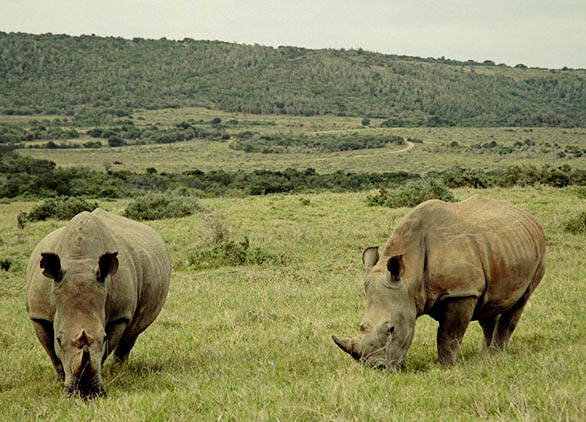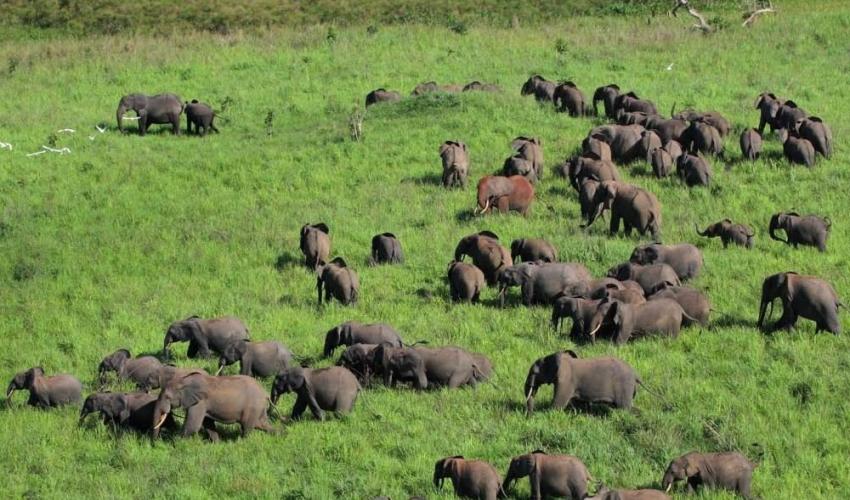Garamba National Park
Covering vast grass savannas and woodlands interspersed with gallery forests and marshland depressions, Garamba National Park is located in the north-eastern part of the Democratic Republic of the Congo (DRC) in the transition zone between the dense tropical forests of the Congo Basin and the Guinea-Sfcongudano savannas. It contains the last worldwide population of the northern white rhinoceros, endemic sub-species of Congolese giraffe and a mixed population of elephants, combining forest elephants, bush elephants and individuals demonstrating morphological characteristics common to the two elephant sub-species. It is also characterized by an exceptionally high level of biomass of great herbivores as a result of the vegetation productivity of the environment. Extending over 490,000 ha and surrounded by 752,700 ha of three hunting grounds that contribute to an effective protection of the property against threats from the adjacent area, this property is an outstanding sanctuary with its unusual mix of large spectacular mammals.

Garamba National Park and its neighboring hunting grounds offers a vast area scattered with a dense network of small permanent springs that support an exceptionally high plant productivity and herbivore biomass. This biomass translates for example in the presence of large herds of elephants at certain periods of the year, sometimes herds of more than 550 individuals, an exceptional natural phenomenon.
Garamba National Park contains the four largest land mammals in the world, the elephant, the rhinoceros, the giraffe and the hippopotamus. The northern white rhinoceros population is the last surviving population of this sub-species. In addition, the sub-species of the Congolese giraffe is also endemic to the Park. Located in the transition zone between the Guinean-Congo and Guinean-Sudanese endemism centres, the Park and the nearby hunting domains contain a particularly interesting biodiversity with species typical of the two biogeographical zones. In addition to the rhinoceros and the giraffe, the purely savannicole species include the lion, the spotted hyena and numerous species of antelope. Furthermore, the species typical of the forest include the bongo, the forest hog, the chimpanzee and five species of small diurnal primates. The Park is also one of the rare places in Africa where one can observe both the African forest elephant Loxodonta africana cyclotis and the African bush elephant Loxodonta africana africana, as well as hybrid elephants presenting morphological characteristics common to both sub-species. A very large population of African buffalo also display intermediary forms between the forest buffalo Syncerus caffer nanus and the savannah buffalo Syncerus caffer aequinoctialis.

Garamba National Park is delineated to the east, south and west by major rivers that constitute natural and precise boundaries, recognized by all. To the north, it shares its boundaries with the Lantoto National Park in South Sudan, offering interesting possibilities of protection on the transfrontier and regional level. In a virgin landscape, no human presence or installations were indicated in the Park at the time of the nomination and the peripheral population was sparse. Garamba National Park is surrounded by three large contiguous hunting grounds, constituting an ecosystem of a sufficiently extensive area (1,242,700 ha) to support vast populations of large mammals with their local seasonal migration routes. The hunting grounds contribute towards the effective protection of the property against the threats from the surrounding zone. Their value is primordial, particularly for the seasonal movement of elephants and for the maintenance of viable populations of bush species.
Garamba National Park has had the status of National Park since 1938 under the management authority of the Congolese Institute for Nature Conservation (ICCN). It is managed by the three administrative sectors of Nagero, Gangala na Bodio and Beredwa at the northern limit, each having buildings and road infrastructures. The establishment of a management plan is an indispensable condition in the management of the Park, given the importance of these hunting grounds for the integrity of the property, they should benefit from an integrated management with the Park.
It is essential that the integration of the local communities in the management of the Park and the peripheral hunting grounds, through a community conservation approach, be established through the participatory management of natural resources.
Surveillance is ensured by the guards through patrols in the three hunting grounds as well as in the Park, in liaison with regular aerial patrols of all these zones. The tourism aspect has been developed and the possibility, unique in Africa, of tourism on elephant back existed; this activity could be revived once the security situation is more stable.
Partnerships with international bodies and sufficient fund-raising for an effective conservation of the property should also be reinforced, ideally including the creation of a Trust Fund.


